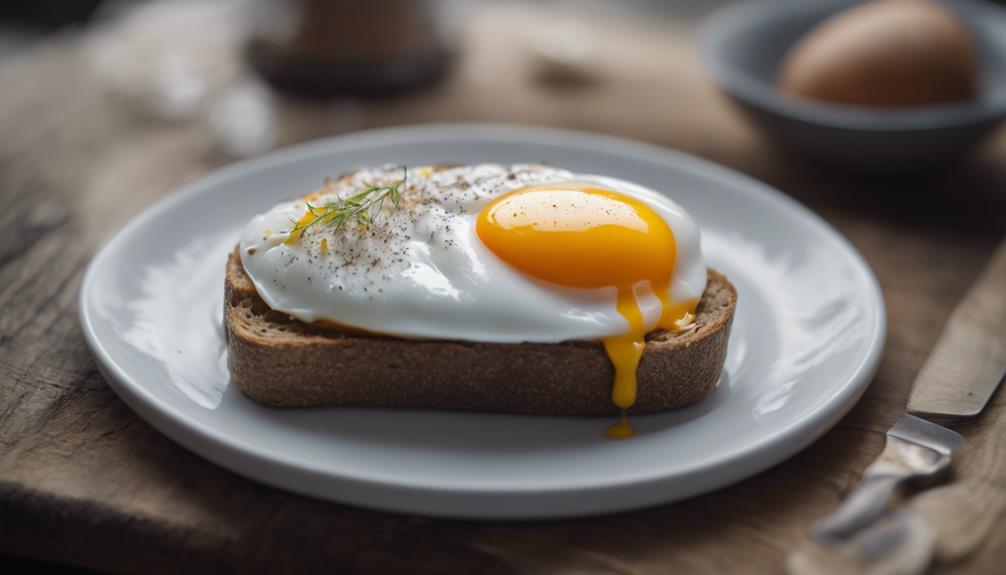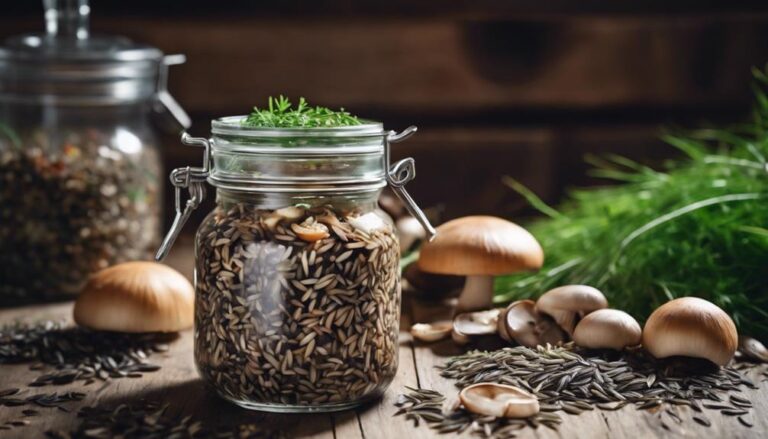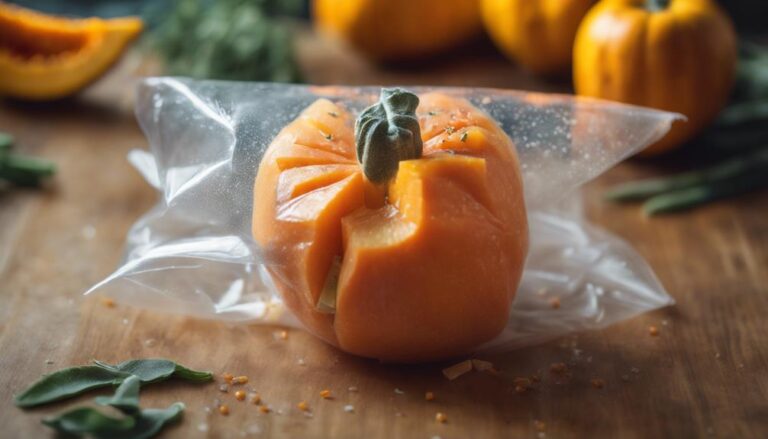Nordic Rye Bread With Sous Vide Poached Eggs
Indulge in the culinary journey of Nordic Rye Bread with perfectly sous vide poached eggs. The hearty rye bread provides a sturdy base, harmonizing with the immaculately cooked eggs. Avocado hollandaise offers a healthier twist to traditional sauces, elevating the dish. The interplay of textures and flavors will leave your taste buds delighted. With the addition of arugula, lobster tail, and warm hollandaise, this dish transforms into a decadent meal worth savoring. Discover the blend of tradition and innovation in each bite and experience a symphony of tastes that will tantalize your senses.
What You Will Learn Here
- Nordic rye bread offers a hearty base for the dish.
- Sous vide method ensures perfectly poached eggs.
- Avocado hollandaise adds a healthy twist to the sauce.
- Combination with arugula and lobster tail creates a decadent meal.
- Blend of textures and flavors make this dish appealing.
Rye Bread Origins
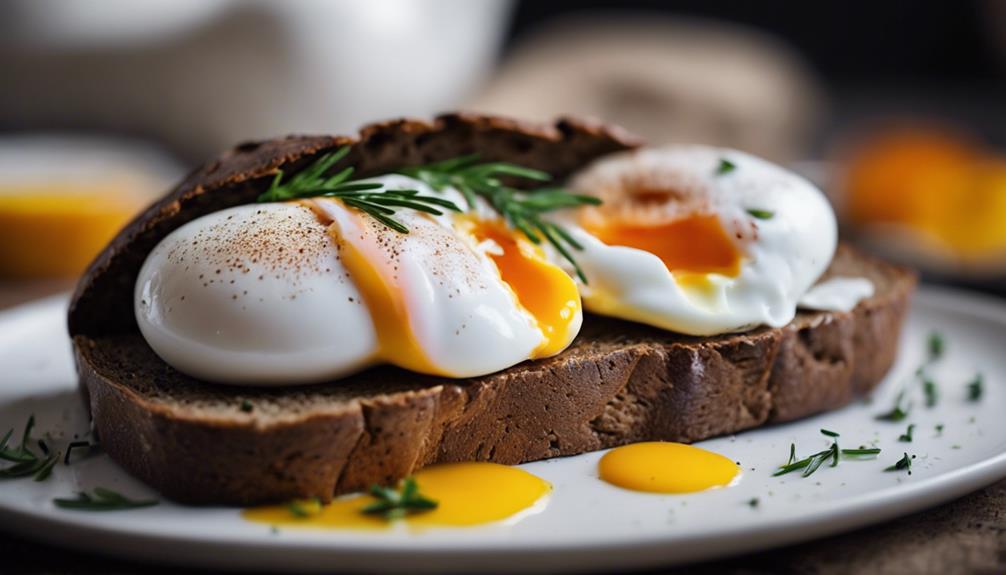
Rye bread has a rich history rooted in the Nordic countries, where it has been a dietary staple for generations. The dense and robust texture of traditional Nordic rye bread, often made with a sourdough starter, reflects the region's commitment to hearty, long-lasting sustenance.
Delving into the origins of rye bread opens a window into the broader cultural significance of Scandinavian bread-making practices.
Rye Bread History
During the Middle Ages in the Nordic regions, the cultivation of rye and its transformation into bread played a pivotal role in shaping the local cuisine and dietary habits. Rye bread, with its deep roots in Nordic history, was a practical solution to the challenging climate and soil conditions of the region.
The traditional use of sourdough starter cultures in rye bread baking not only aided in fermentation but also contributed to the unique flavors that Nordic rye bread is known for today. The dense texture, nutty taste, and long shelf life of Nordic rye bread made it a staple in the diet, reflecting the close connection between food, culture, and agriculture in the Nordic countries.
Traditional Rye Recipes
With a legacy rooted deep in the annals of Nordic culinary traditions, these time-honored recipes for traditional rye breads offer a tantalizing glimpse into the rich tapestry of flavors that have sustained generations in the region. Danish Rye, a particular favorite, showcases the robust and earthy essence of rye.
The dense texture and nutty undertones of Nordic rye bread are complemented by a sourdough starter, adding depth to its flavor profile. Ingredients like rye flour, water, salt, and seeds such as caraway, sunflower, or pumpkin contribute to its unique taste and texture.
The overnight pre-fermentation process and high-temperature baking method result in the chewy crust and moist crumb that define authentic Nordic rye bread.
Nordic bread culture embodies a rich tapestry of traditions that have shaped the essence of Scandinavian culinary heritage. Rye bread, a cornerstone of this culture, traces its origins back centuries in Denmark, Sweden, and Finland.
The dense and hearty texture of traditional Nordic rye bread comes from a simple yet essential combination of rye flour and water. Historically, the reliance on rye crops in the harsh northern European climate made this bread an essential and enduring source of sustenance.
Each Scandinavian country has its own unique take on rye bread, often incorporating seeds like caraway or sunflower to enhance flavor. The artisanal methods involved, such as pre-fermentation and high-temperature baking, contribute to the distinct texture and taste that define this beloved staple of Scandinavian cuisine.
Rye Bread Flour Varieties
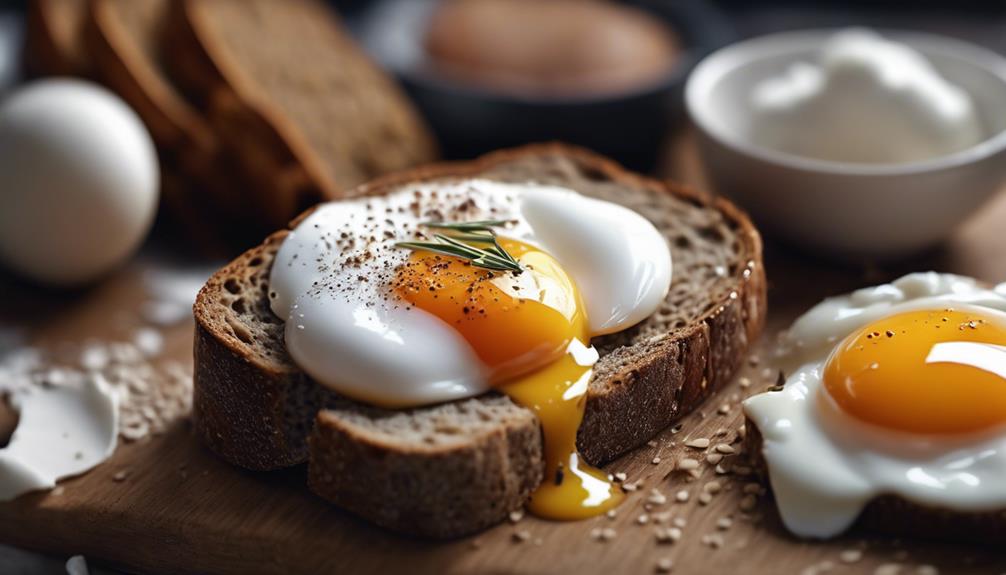
Rye bread flour varieties play a significant role in determining the flavor, texture, and nutritional profile of Nordic rye bread. When crafting your Nordic rye bread recipe, the choice of rye flour can elevate your baking experience. Consider the following varieties:
- Dark Rye Flour (Pumpernickel): Coarsely ground, this flour adds a rich, deep flavor to your Nordic rye bread, creating a robust and hearty taste that pairs beautifully with poached eggs.
- Light Rye Flour: Finely ground, this flour contributes to a lighter texture in your rye bread, making it perfect for those who prefer a softer crumb to complement the silkiness of poached eggs.
- Whole Grain Rye Flour: With the entire rye kernel included, this flour provides a rustic texture and a nutritional boost to your Nordic rye bread, enhancing its fiber content and earthy notes.
When exploring Scandinavian rye bread variations, you'll encounter a delightful array of options that cater to diverse palates. From classic open-faced sandwiches topped with butter and honey glaze to slices toasted with a sprinkle of cinnamon sugar, the possibilities are as varied as they're delicious.
These inventive variations showcase the adaptability of Scandinavian rye bread, elevating it from a staple to a culinary delight.
Rye Bread Open-Faced Sandwiches
For creating delectable Scandinavian rye bread open-faced sandwiches, explore a variety of traditional and modern toppings to elevate your smørrebrød experience. Danish rye bread, with its dense texture and rich flavor, serves as the perfect canvas for a multitude of delicious combinations.
Here are some suggestions to inspire your next smørrebrød creation:
- Smoked salmon, dill, and pickled cucumber on buttered rye bread.
- Roast beef, horseradish cream, and crispy fried onions atop Danish rye bread.
- Avocado, cherry tomatoes, and a sprinkle of sea salt on toasted rye bread with a drizzle of olive oil.
These flavorful pairings showcase the versatility of rye bread and its ability to complement a wide range of ingredients, making each bite a delightful experience.
Butter and Honey Glaze
To enhance the indulgent experience of your Scandinavian rye bread, consider exploring the rich and sweet notes of a traditional butter and honey glaze. This decadent topping not only adds a delightful sweetness but also complements the nutty flavors of the rye bread, creating a harmonious blend for your taste buds.
The combination of butter and honey offers a perfect balance of richness and sweetness, elevating the overall taste experience of your meal. As the glaze melts into the warm bread, it forms a glossy sheen on the crust, enhancing both the visual appeal and the mouthfeel of each bite.
Incorporating this butter and honey glaze can truly transform your Nordic rye bread with sous vide poached eggs.
Toasted With Cinnamon Sugar
Indulge in the comforting sweetness of cinnamon sugar toasted on Nordic rye bread, creating a delightful contrast to its nutty and dense texture. When you bite into this flavorful combination, you experience a symphony of tastes and textures:
- The warm aroma of cinnamon envelopes your senses, enticing you to take another bite.
- The crispy edges of the toasted bread provide a satisfying crunch, enhancing the overall eating experience.
- As you savor the sweetness of the cinnamon sugar, it harmonizes with the earthy flavors of the rye bread, creating a perfect balance of taste profiles.
Toasting your bread with cinnamon sugar not only elevates its flavor but also transforms it into a comforting treat that pairs beautifully with poached eggs for a delightful meal.
Rye Bread Storage Tips
When it comes to storing Nordic rye bread, opt for a paper bag or cloth to maintain its texture and prevent dryness. Avoid using plastic bags as they can trap moisture and promote mold growth, compromising the bread's quality.
Freezing rye bread can extend its freshness for up to three months, just remember to thaw it properly for the best results.
Proper Rye Bread Storage
For peak freshness and texture, store your Nordic rye bread in a paper bag or cloth to prevent it from drying out. By maintaining it at room temperature for 3-4 days, you guarantee the best taste.
If you want to extend its shelf life, tightly wrap the rye bread in plastic wrap or aluminum foil and store it in a cool, dark place. Remember, refrigeration can make rye bread stale and affect its texture, so it's best to avoid it.
Freezing your rye bread is a great option for long-term storage; individually wrap slices in plastic wrap before freezing to maintain its quality.
Following these storage tips will help you enjoy fresh and delicious rye bread every time you reach for a slice.
Lengthening Bread Freshness
To maintain the peak freshness of your Nordic rye bread, proper storage techniques play a crucial role in preserving its taste and texture over time.
Store your rye bread in a paper bag or cloth to allow it to breathe while protecting it from drying out. Avoid using plastic bags, as they can trap moisture and lead to spoilage.
For best taste and texture, keep your rye bread at room temperature for up to 3 days. If you want to extend its freshness, freeze the bread in a sealed bag for up to 3 months.
When thawing frozen rye bread, do so at room temperature or in the refrigerator to prevent it from becoming soggy. Proper storage will make sure your bread complements perfectly with your poached eggs.
Preventing Bread Spoilage
Storing Nordic rye bread in a paper bag or bread box allows for proper air circulation, preventing mold growth and maintaining its freshness. Guarantee your Danish rye bread stays fresh by keeping it at room temperature for 3-4 days.
For longer storage, freeze sliced rye bread in airtight bags for up to 3 months, maintaining its quality. If your rye bread becomes stale, lightly moisten it with water and heat it in the oven at 350°F for 10-15 minutes to refresh it.
Final Thoughts
What key aspects contribute to the overall appeal of this unique Nordic rye bread with sous vide poached eggs combination?
The allure of this dish lies in the harmonious blend of textures and flavors. The dense and robust Nordic rye bread serves as a sturdy base, providing a perfect canvas for the delicate and velvety sous vide poached eggs. The sous vide method guarantees that each egg is impeccably cooked, with whites set just right and yolks luxuriously runny. This precision in cooking temperature secures a consistent and high-quality poached egg experience every time.
Moreover, the addition of avocado hollandaise introduces a twist to the traditional hollandaise sauce, offering a healthier yet equally flavorful alternative. When combined with fresh arugula, succulent lobster tail, and a drizzle of warm hollandaise, this dish transforms into a decadent and satisfying meal that tantalizes the taste buds. The interplay of textures, the richness of the eggs, and the earthy undertones of the rye bread elevate this dish to a culinary delight that's both comforting and indulgent.
Frequently Asked Questions
Can You Poach Eggs in a Sous Vide?
Yes, you can poach eggs in a sous vide! This technique guarantees precise cooking, resulting in perfectly set whites and creamy yolks. It's a game-changer for breakfast recipes and makes cooking eggs a breeze.
What Is the Best Temperature for Sous Vide Eggs?
For the best egg texture, set your sous vide at 145°F. This temperature guarantees firm whites and a lusciously runny yolk. Adjust cooking time to your preference, experimenting with precision for that perfect consistency.
What Is the Best Trick for Poached Eggs?
For perfect poached eggs, make sure your eggs are fresh and set aside 15 minutes. Create a gentle water whirlpool, crack the eggs, and let them cook to perfection. Silicone molds can also help shape your eggs beautifully.
Why Do Chefs Put Vinegar in Poached Eggs?
When poaching eggs, chefs add vinegar for quicker coagulation of egg whites, maintaining shape. It prevents spreading too much in water, yielding firm whites and creamy yolks. If vinegar isn't preferred, lemon juice can offer similar benefits.
Conclusion
Indulge in the rich flavors of Nordic rye bread paired with perfectly poached sous vide eggs for a breakfast experience like no other.
The hearty texture of the bread complements the creamy yolk of the eggs, creating a harmonious blend of savory and earthy notes.
With proper storage techniques, you can enjoy this delectable combination for days to come.
Elevate your breakfast routine with this Scandinavian-inspired dish that's sure to satisfy your taste buds.
